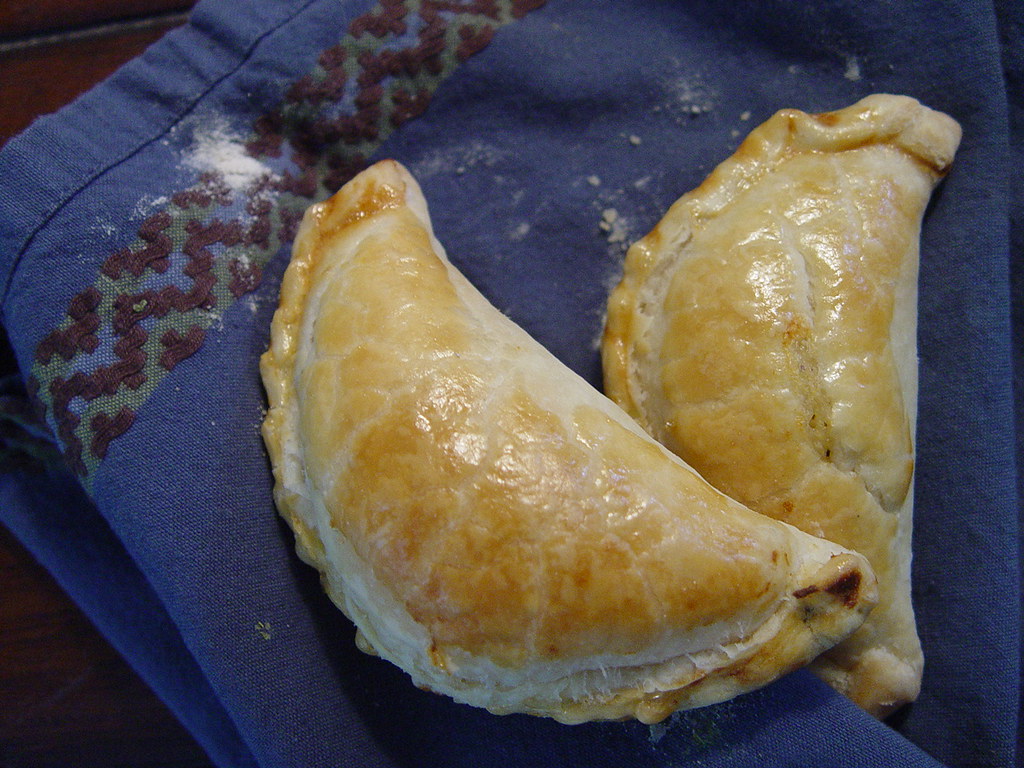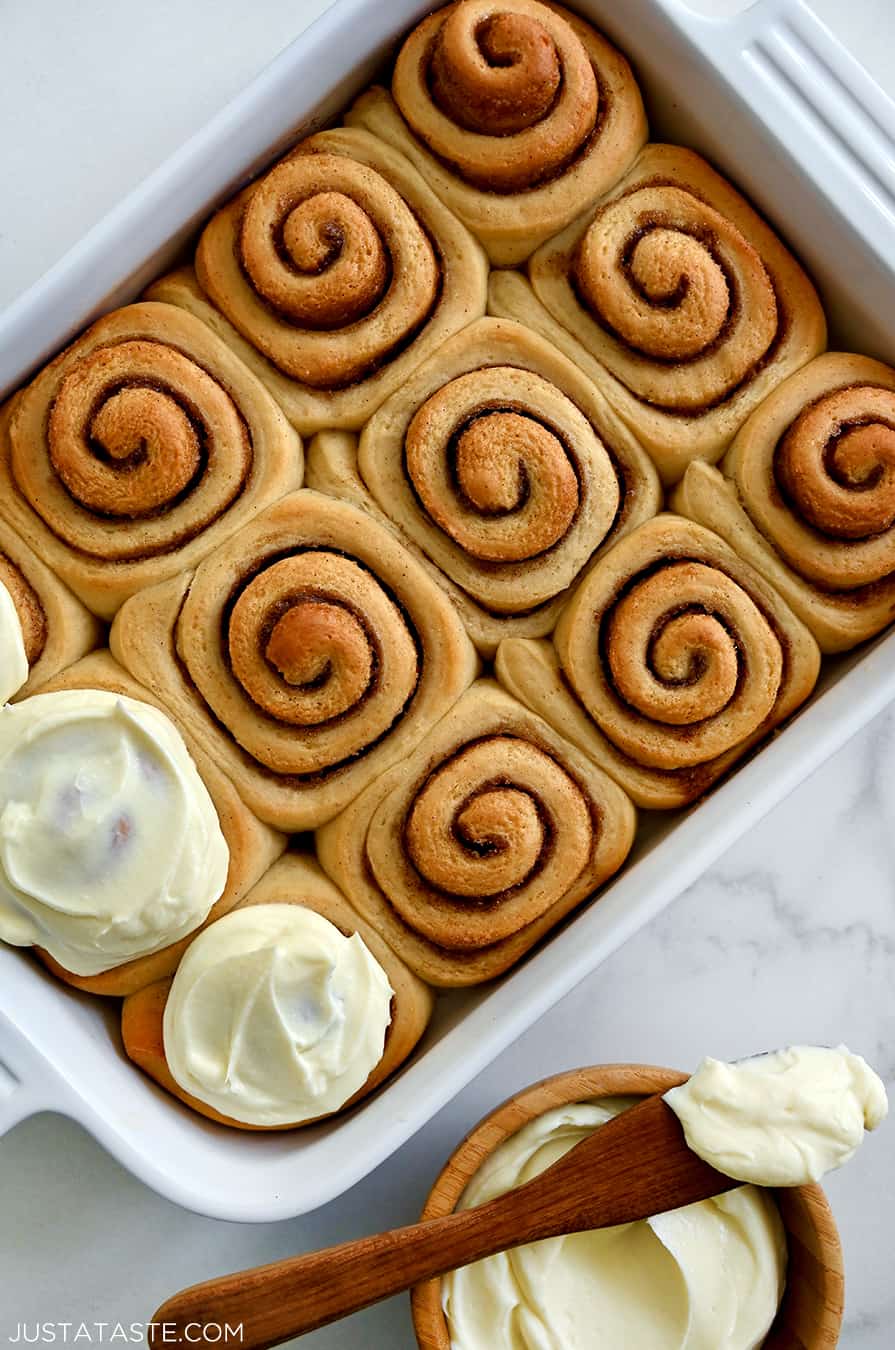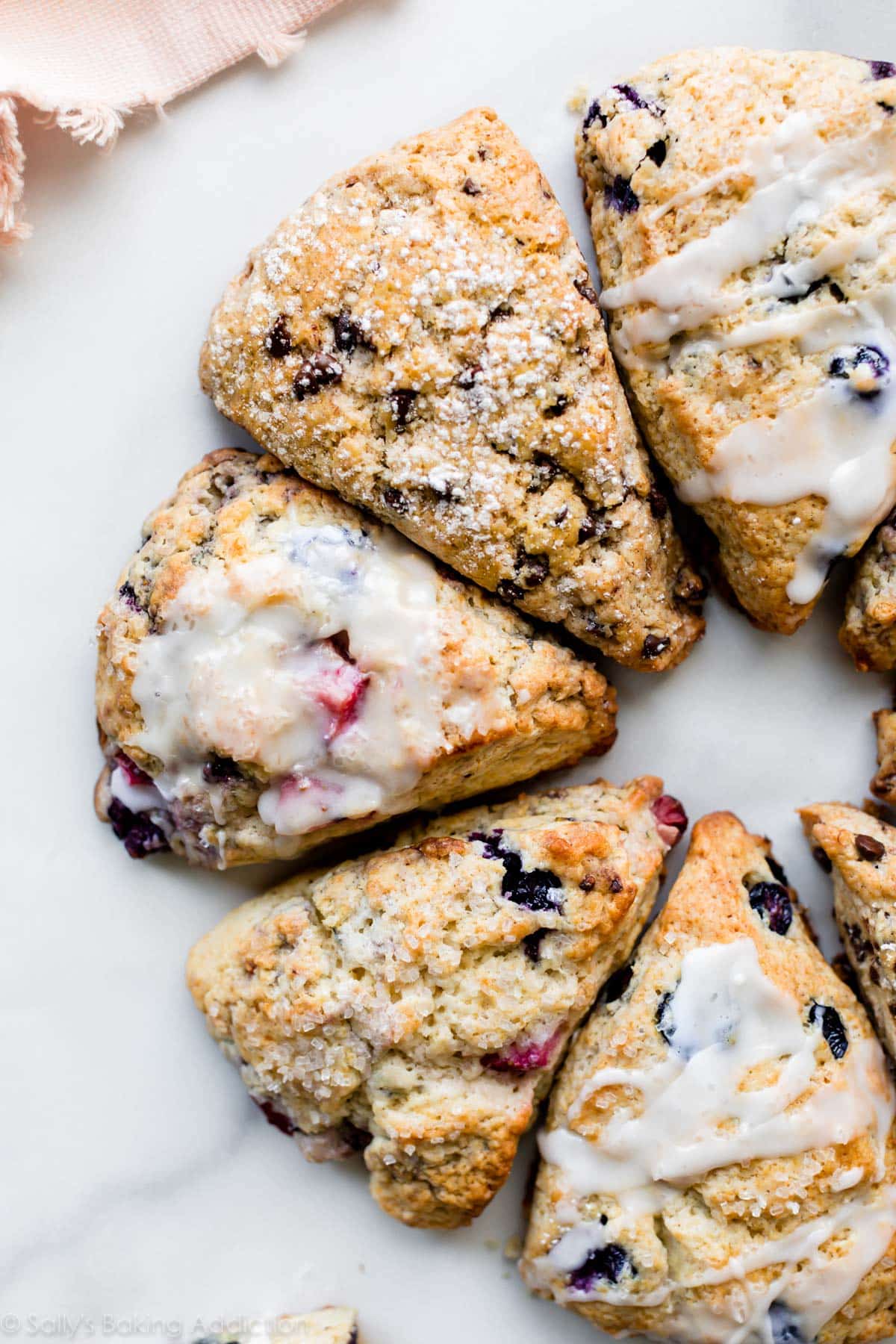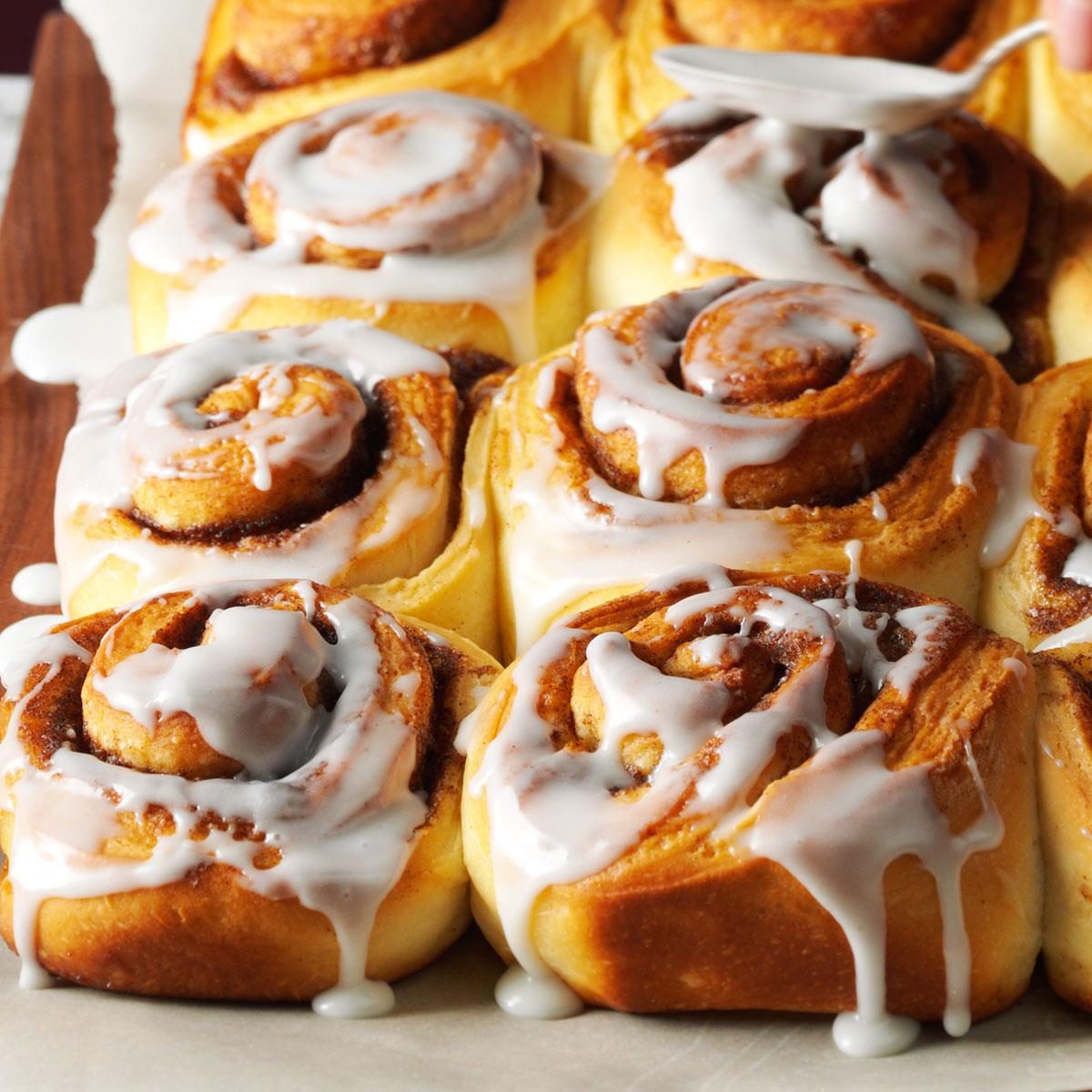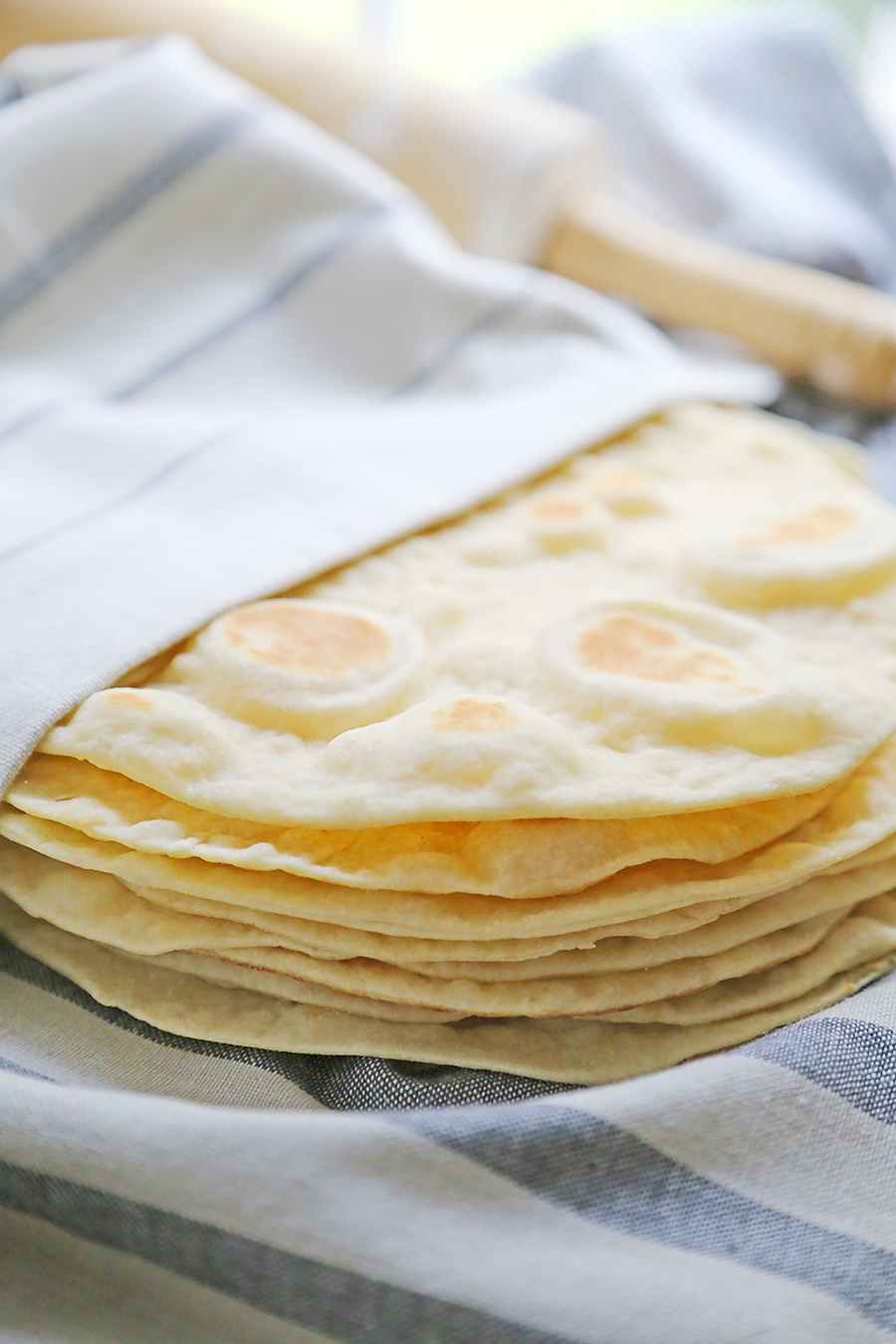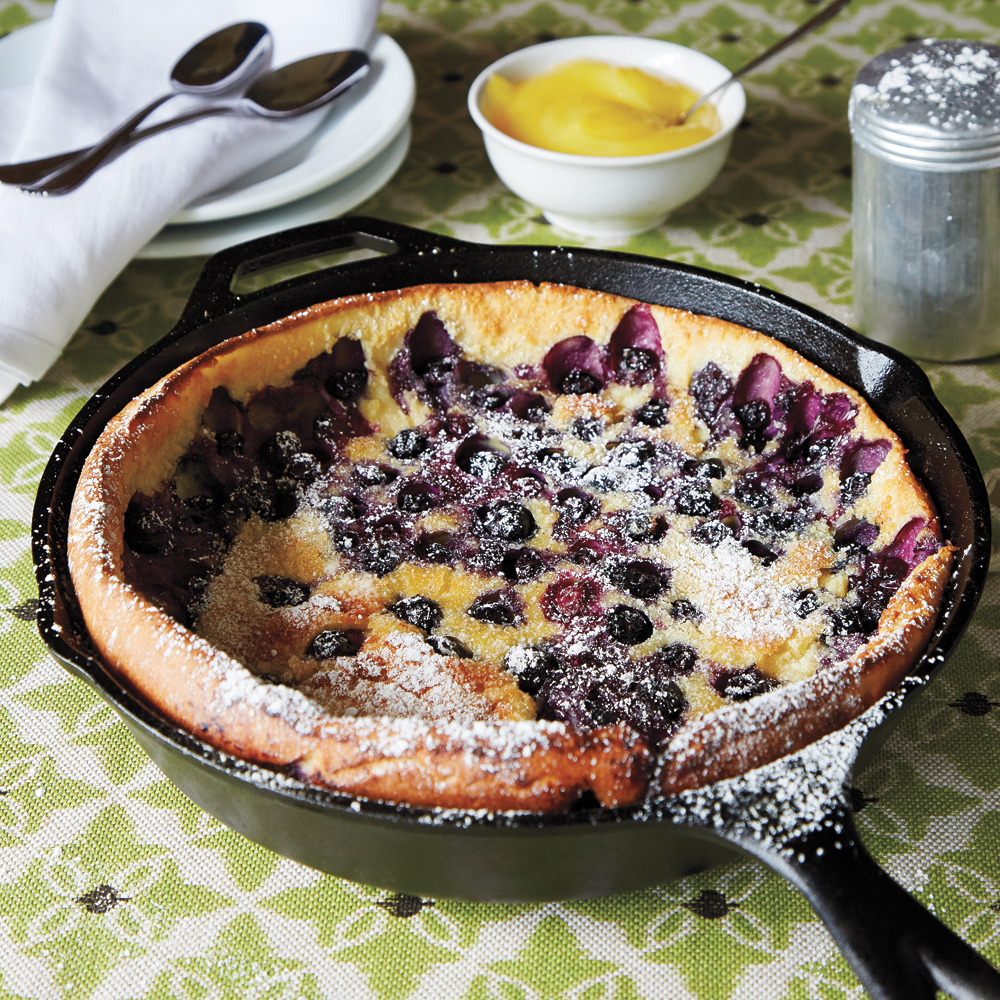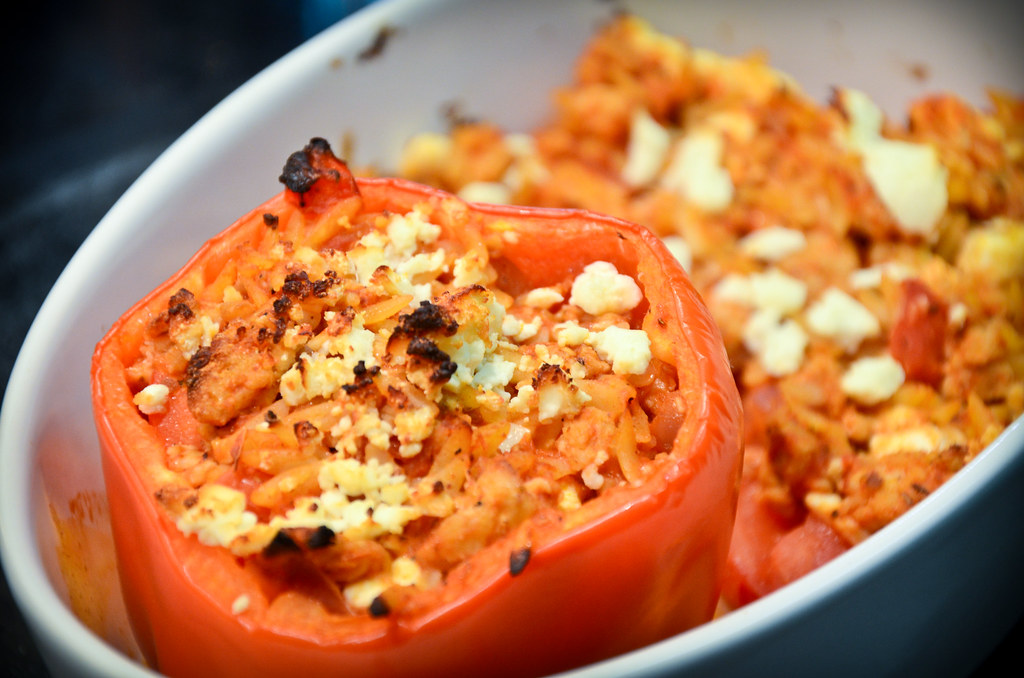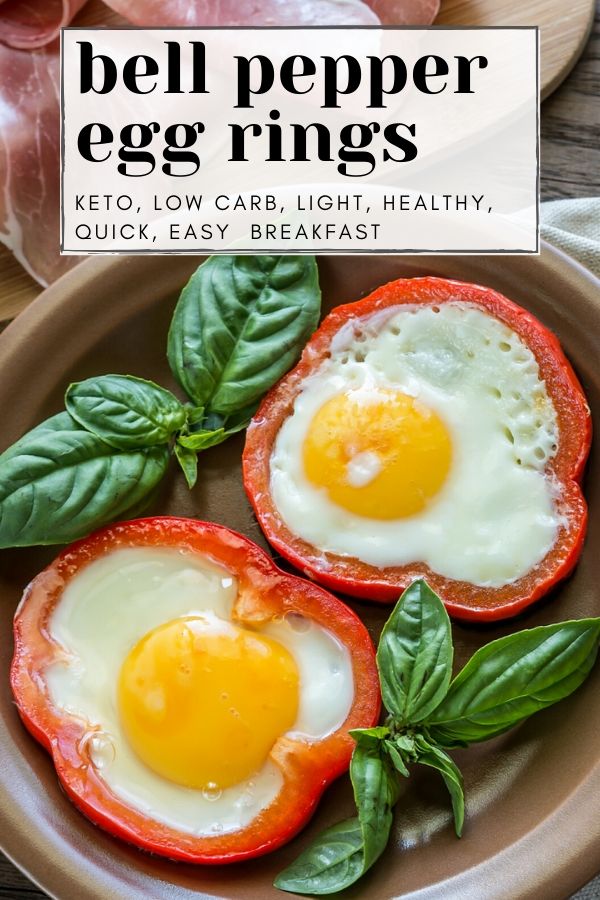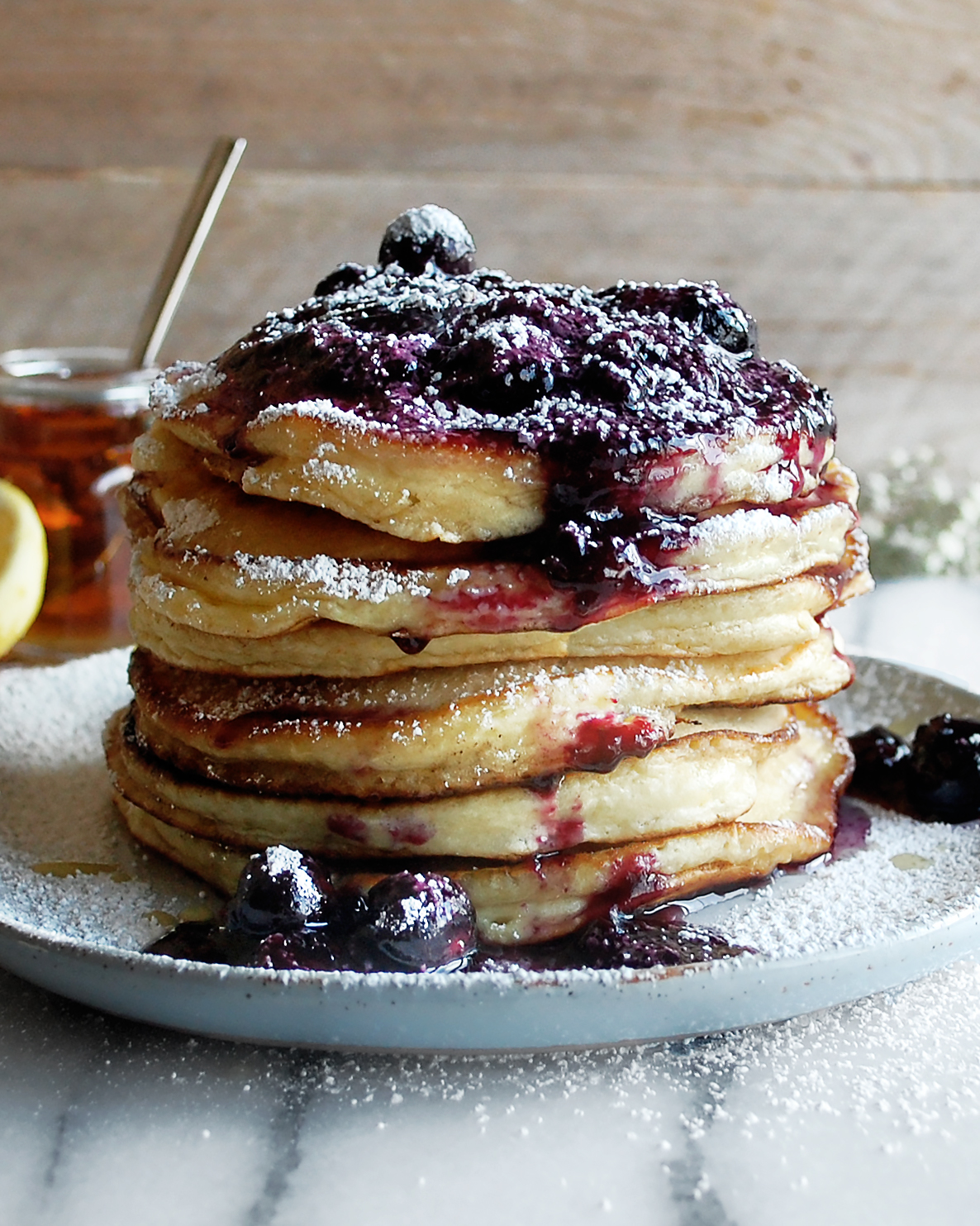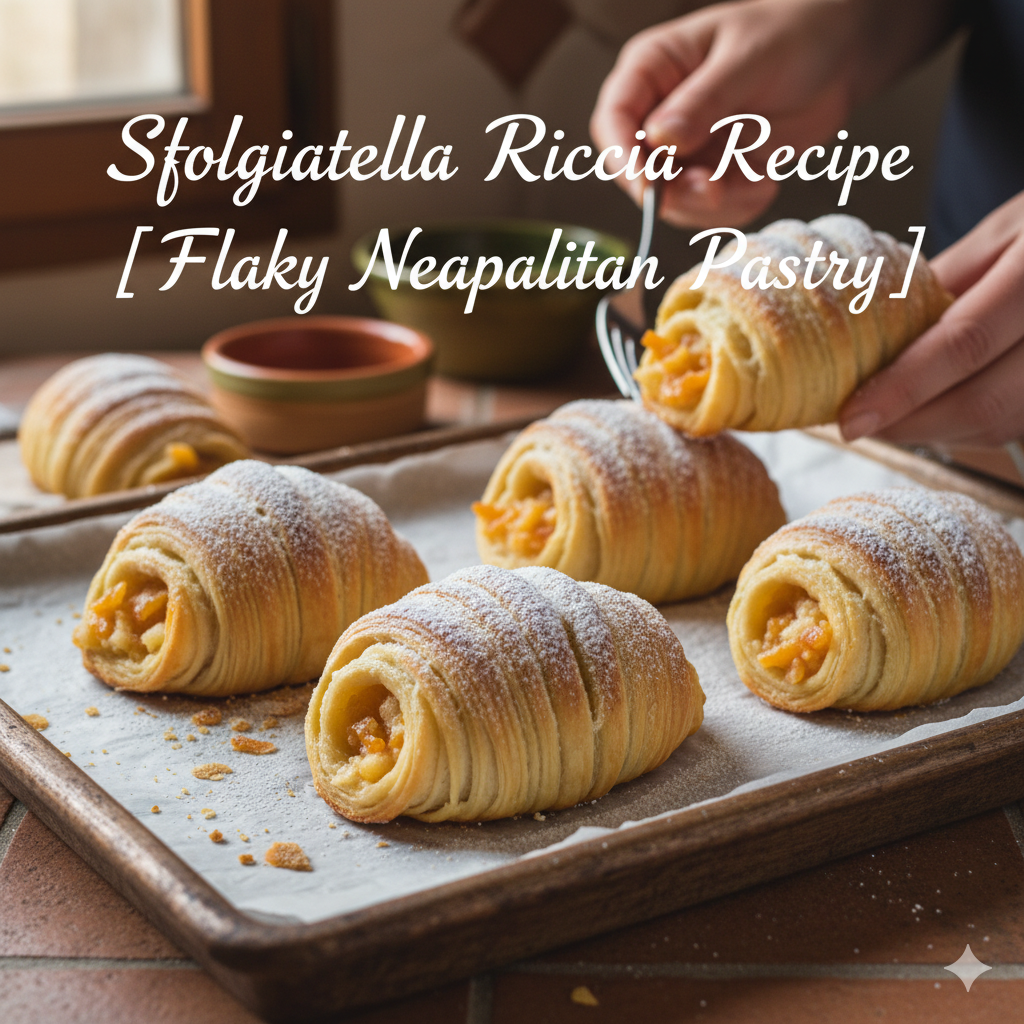
Personal Touch
Growing up, I always associated Sfogliatella with Sunday mornings at a small Italian café where the owner, a cheerful old man named Lorenzo, would proudly line up trays of these golden pastries in his glass case. He used to tell me that the secret to the perfection of this Sfogliatella Riccia Recipe was patience and good butter. I never truly appreciated that advice until I attempted to make it myself.
The first time I made Sfogliatella Riccia at home with this Sfogliatella Riccia Recipe, I underestimated the art of rolling and layering the dough. It took practice to achieve those paper-thin sheets that define the pastry. But once I mastered it, the satisfaction was beyond words. When you hear the sound of those crisp layers shattering under a bite, and the sweet aroma of orange and vanilla fills your kitchen, you understand why Italians treasure this dessert.
This is not a quick dessert. It is a pastry that asks for your attention, your time, and your love. But the reward — that first bite of a perfectly layered, crisp pastry filled with creamy ricotta — makes every step worthwhile. Every time I make it, I am reminded that baking is not just about ingredients; it is about the story, the patience, and the joy behind each creation.
Origin and History Of This Recipe
The Sfogliatella Riccia originated in the Campania region of southern Italy, specifically in the city of Naples, during the 17th century, according to historical records on Wikipedia. The pastry was first created by nuns in a convent in Conca dei Marini, near the Amalfi Coast. The nuns crafted it from leftover semolina and ricotta, adding dried fruits and sugar to form a sweet, rich filling. Later, the recipe made its way to Naples, where it became a symbol of Neapolitan pastry excellence.
In the 19th century, a pastry chef named Pasquale Pintauro discovered the convent’s secret recipe and began selling Sfogliatella in his shop in Naples. His version perfected the flaky, layered shell we know today as Sfogliatella Riccia. Over time, two main varieties evolved:
- Sfogliatella Riccia, which has the crispy, multi-layered shell.
- Sfogliatella Frolla, which features a smooth, shortcrust pastry exterior and is easier to prepare.
While this post focuses on the Sfogliatella Riccia Recipe, you can also explore the softer variant, Sfogliatella Frolla, on AllRecipe.Org for a simpler alternative that retains the same delicious filling but uses a different dough.
Ingredients List
Below are the ingredients you will need to make the authentic Sfogliatella Riccia Recipe. Be sure to use high-quality butter and ricotta for the best texture and flavor.
For the Dough:
- 2 cups (250g) all-purpose flour
- 1/4 teaspoon salt
- 2/3 cup (150ml) warm water
- 3 tablespoons unsalted butter, melted (for the dough)
- 1/2 cup (115g) unsalted butter, softened (for brushing the layers)
For the Filling:
- 1/2 cup (100g) semolina flour
- 1 cup (240ml) milk
- 1 cup (250g) ricotta cheese (well-drained)
- 1/2 cup (100g) granulated sugar
- 1 large egg
- 1 teaspoon vanilla extract
- 1 teaspoon orange zest
- 1/2 teaspoon cinnamon powder
- 2 tablespoons candied orange peel (optional)
For Brushing and Baking:
- Extra butter for brushing
- Powdered sugar for dusting
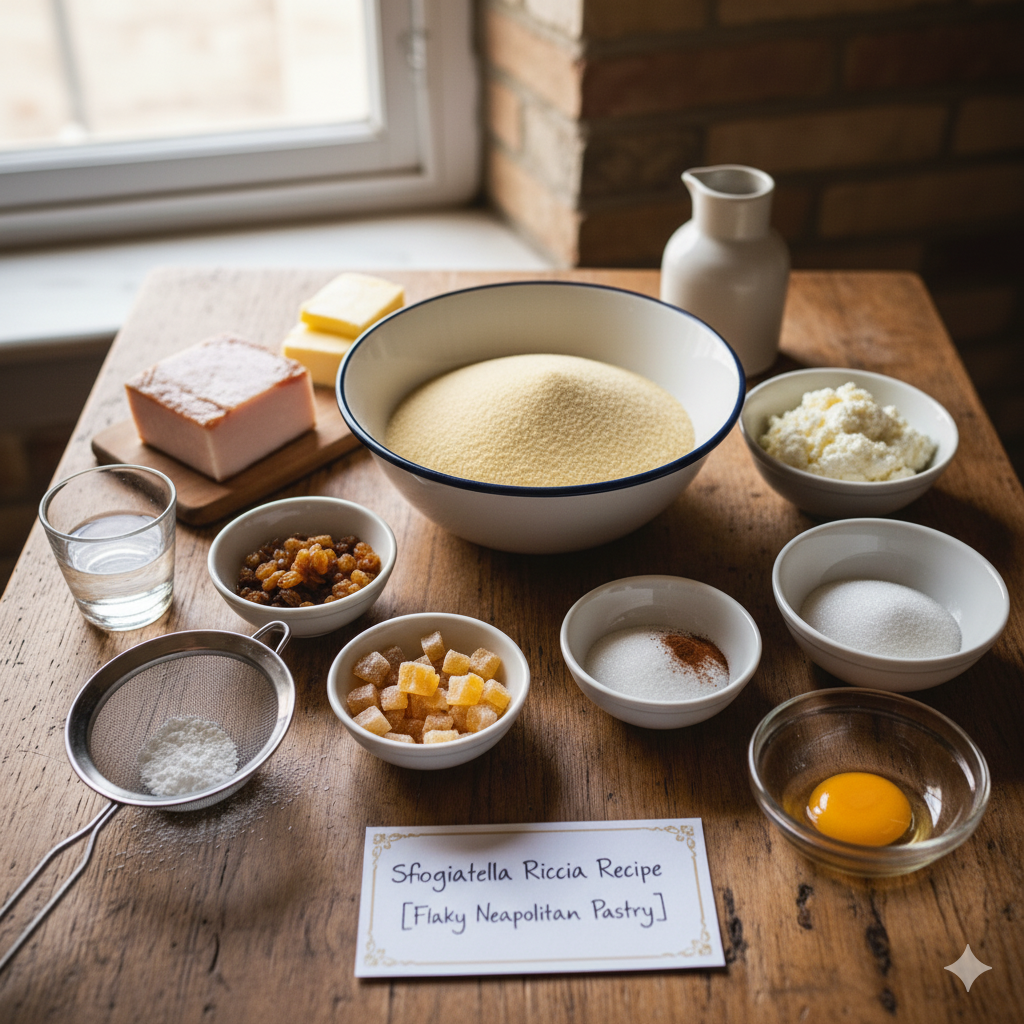
Preparation Steps For Sfogliatella Riccia Recipe
Making the perfect Sfogliatella Riccia Recipe involves precision, patience, and layering. Follow these steps carefully for the best results.
Step 1: Prepare the Dough
- In a large mixing bowl, combine the flour and salt. Gradually add warm water while mixing until a rough dough forms.
- Knead the dough on a lightly floured surface for about 10 minutes until it becomes smooth and elastic.
- Wrap the dough tightly in plastic wrap and let it rest at room temperature for 30 minutes.
Step 2: Prepare the Filling
- Heat milk in a small saucepan over medium heat until it begins to simmer. Gradually whisk in the semolina flour. Stir constantly until the mixture thickens, about 3–4 minutes.
- Remove from heat and allow it to cool.
- In a mixing bowl, combine ricotta, sugar, egg, vanilla extract, orange zest, cinnamon, and candied peel. Mix until smooth.
- Add the cooled semolina mixture and blend well until fully incorporated.
- Cover and refrigerate the filling while you prepare the pastry layers.
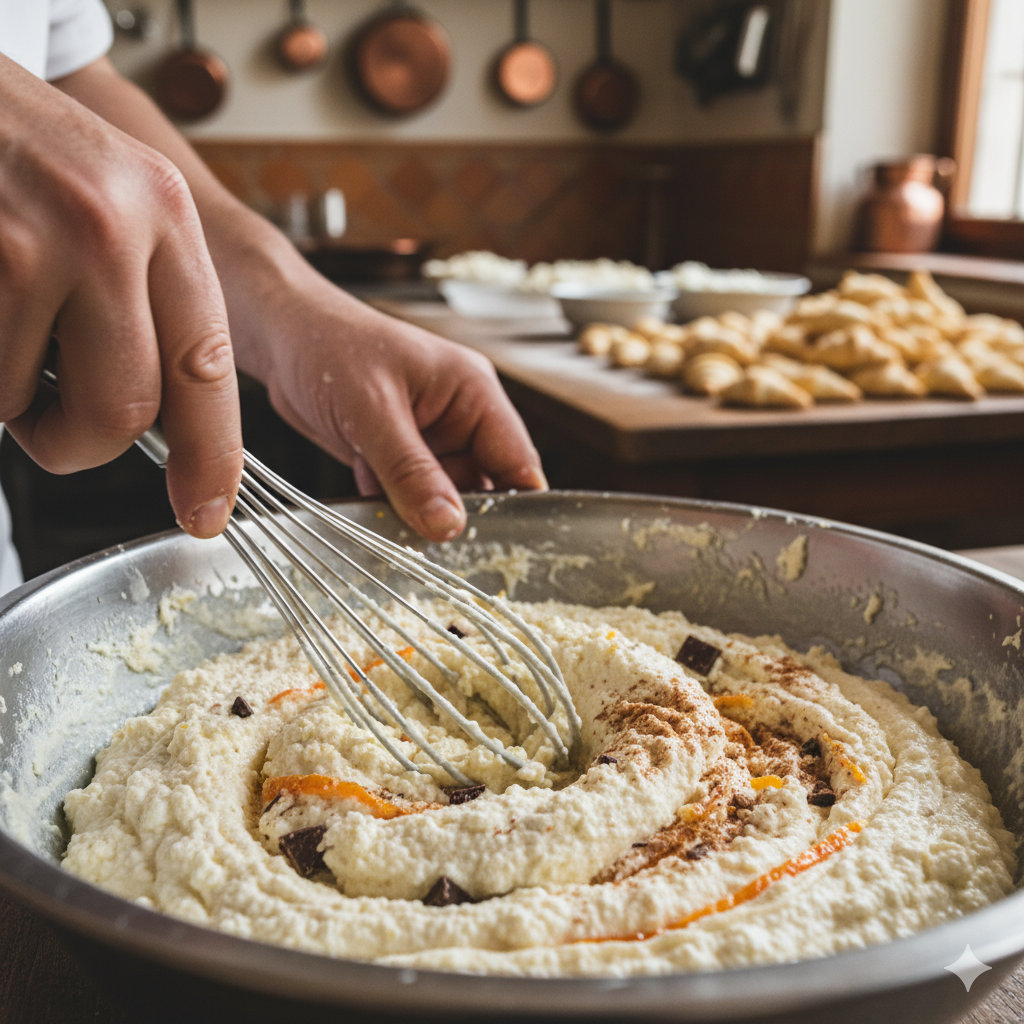
Step 3: Rolling and Stretching the Dough
- Divide the rested dough into two equal portions.
- Using a pasta roller or rolling pin, roll out each portion into a long, thin sheet. The thinner the sheet, the flakier your Sfogliatella will be.
- Brush the entire surface lightly with melted butter.
- Starting from one end, roll the dough into a tight log, brushing with butter as you go. This step creates the multiple flaky layers that define Sfogliatella Riccia.
- Wrap the rolled log in plastic wrap and refrigerate it for at least 1 hour (preferably 2 hours) to firm it up for slicing.
Step 4: Forming the Sfogliatella Shells
- Slice the chilled dough log into 1/2-inch thick pieces.
- Using your thumbs, press the center of each slice and gently stretch the edges outward to form a cone or seashell shape. Be patient — this is what gives Sfogliatella Riccia its signature layered look.
- Spoon a small amount of the ricotta filling into the center of each shell.
- Carefully pinch the open edge to seal. Repeat for all pieces.
Step 5: Baking
- Preheat your oven to 400°F (200°C).
- Place the filled pastries on a parchment-lined baking sheet.
- Bake for 20–25 minutes or until golden brown and crisp.
- Allow to cool slightly, then dust with powdered sugar before serving.
Variations or Substitutions
While Sfogliatella Riccia is traditionally made with semolina and ricotta, there are creative ways to adapt it:
- No candied peel: Substitute with a few drops of orange essence for similar flavor.
- Vegan variation: Replace butter with coconut oil and use a plant-based ricotta alternative.
- Sweetener swap: Use honey or agave syrup instead of sugar for a softer sweetness.
- Flavor twist: Add lemon zest or a hint of almond extract for unique flavor notes.
You can also mention the Sfogliatella Frolla version on your website, which uses a smooth, shortcrust dough instead of layers, making it easier for beginners to try at home.
Cooking Time & Servings
- Preparation time: 1 hour 30 minutes (including dough resting and filling prep)
- Cooking time: 25 minutes
- Cooling and finishing: 15 minutes
- Total time: About 2 hours 10 minutes
- Servings: 10–12 pastries
Serving Suggestions
Sfogliatella Riccia is best enjoyed warm, just minutes after baking, when its crisp layers are at their finest. Traditionally, Italians serve it with espresso or cappuccino for breakfast or as a sweet afternoon treat.
For a more decadent experience:
- Dust with extra powdered sugar right before serving.
- Pair with lemon sorbet or gelato for a refreshing contrast.
- Serve on a rustic wooden board with slices of fresh orange for visual appeal.
- Drizzle lightly with honey for a glossy finish.
Common Mistakes People Make In Sfogliatella Recipe
Making Sfogliatella Riccia is a true test of patience and technique. Even seasoned bakers sometimes encounter challenges. Here are the most common mistakes and how to avoid them:
- Not Rolling the Dough Thin Enough
The key to achieving those signature flaky layers is rolling the dough paper-thin. If it’s too thick, your pastries will turn heavy and chewy instead of crisp and delicate. - Skipping the Resting Period
Resting allows the gluten in the dough to relax, making it easier to stretch and roll. If you rush this step, the dough will shrink and tear easily. - Overfilling the Shells
Adding too much ricotta filling causes the pastry to burst open during baking. Stick to about one tablespoon of filling per pastry for perfect results. - Using Cold Fat During Rolling
Butter or lard should be soft but not melted. Cold fat won’t spread evenly, while melted fat will ruin the dough’s structure. - Underbaking or Overbaking
Underbaked Sfogliatella turns soggy, and overbaked ones become too brittle. Bake until golden brown — around 25–30 minutes. - Skipping the Drainage of Ricotta
Ricotta must be well-drained before use. Too much moisture leads to a watery filling that seeps into the dough.
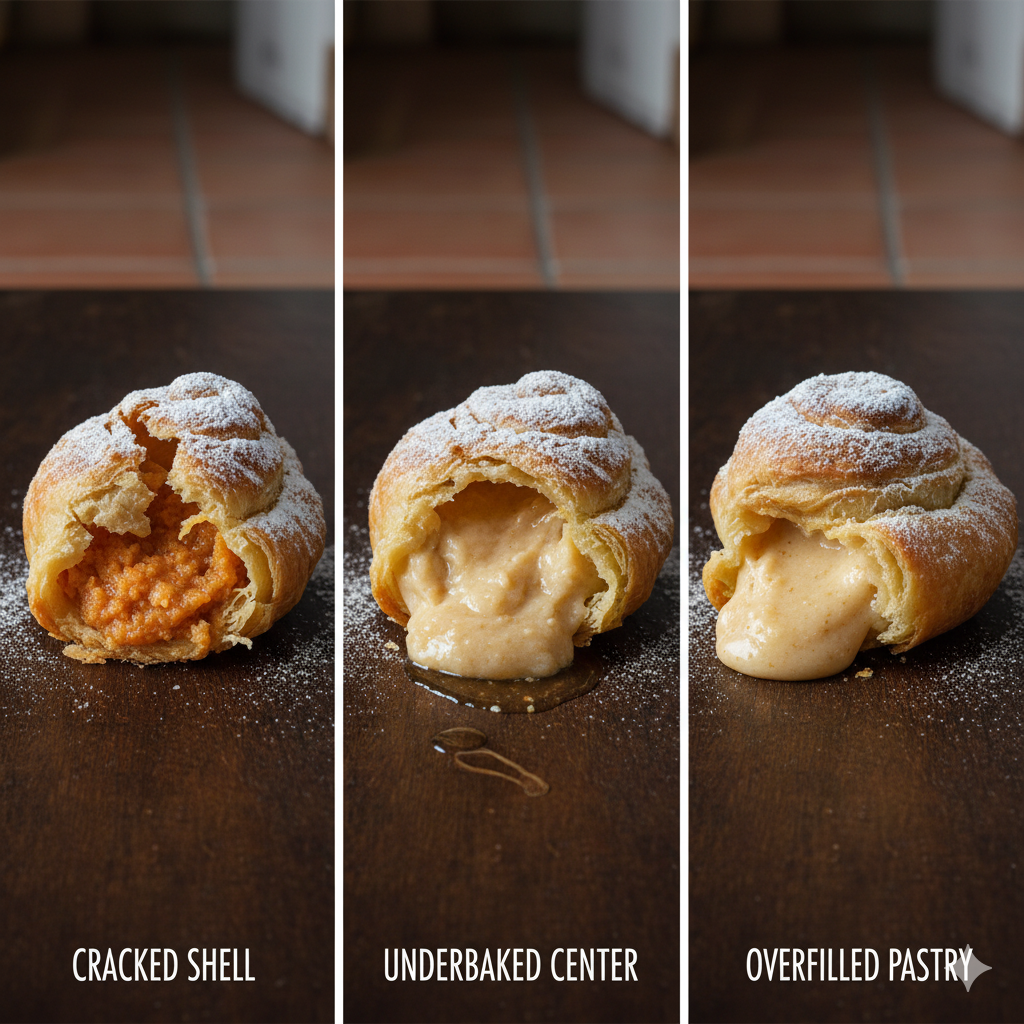
Common Problems and Solutions in Making Sfogliatella Recipe
Problem: The dough tears while shaping.
Solution: Let the dough rest longer and dust lightly with flour while shaping. Elastic dough is easier to stretch without tearing.
Problem: The layers don’t separate during baking.
Solution: You may not have brushed enough butter or lard between layers. Apply a generous but even coating during the rolling stage.
Problem: Filling leaks out during baking.
Solution: Ensure edges are properly sealed and don’t overfill. If the filling looks runny, chill it for 15 minutes before use.
Problem: The pastry is too hard after cooling.
Solution: You may have overbaked it or used too little fat. Always check at the 25-minute mark and store leftovers properly to maintain texture.
Nutritional Information
Below is an approximate nutritional breakdown per serving (1 pastry):
| Nutrient | Amount |
|---|---|
| Calories | 310 kcal |
| Carbohydrates | 38 g |
| Protein | 8 g |
| Fat | 15 g |
| Saturated Fat | 9 g |
| Cholesterol | 60 mg |
| Sodium | 120 mg |
| Sugars | 15 g |
| Fiber | 1 g |
| Calcium | 80 mg |
| Iron | 1.2 mg |
These values may vary depending on portion size and ingredient brands used.
Health Conditions And People To Avoid This
While Sfogliatella Riccia is a delightful treat, certain individuals should consume it cautiously or avoid it altogether due to specific health conditions.
- People with Lactose Intolerance
The filling contains ricotta and milk, both high in lactose. Consuming this pastry can cause bloating, cramps, or digestive distress. - Individuals with High Cholesterol
The recipe includes butter, lard, and eggs — ingredients rich in saturated fats. Overconsumption can raise LDL (bad) cholesterol levels. - Diabetics
Sugar content is relatively high, making it unsuitable for those who must manage blood glucose levels. - Those with Gluten Sensitivity or Celiac Disease
Sfogliatella Riccia is made with wheat flour. Unless using certified gluten-free flour, it can trigger symptoms in sensitive individuals. - People with Heart Disease or Hypertension
The saturated fat content can increase blood pressure and strain cardiovascular health if eaten frequently. - Obesity and Weight Management Patients
Its calorie density makes it unsuitable for strict low-calorie diets or weight-loss regimens.
In all these cases, moderation or ingredient substitutions (such as low-fat ricotta and butter alternatives) are recommended.
Nutrition and Benefits To The Body
Despite being an indulgent pastry, Sfogliatella Riccia provides several beneficial nutrients:
- Protein (from ricotta and egg): Supports muscle repair and energy metabolism.
- Calcium (from dairy): Strengthens bones and teeth.
- Carbohydrates (from flour and sugar): Provide quick energy for the body.
- Vitamin B2 and B12 (from dairy): Essential for brain function and red blood cell production.
- Zinc and Iron (from eggs and flour): Help maintain immune health and oxygen transport.
- Healthy Fats (from butter and eggs): Aid in hormone balance and nutrient absorption.
These nutrients make Sfogliatella more than just a dessert — it’s a balanced indulgence when enjoyed occasionally.
Disadvantages Of This Sfogliatella Riccia Recipe
Every nutrient, when overconsumed, can become harmful:
- Excess Carbohydrates: May spike blood sugar and lead to energy crashes.
- Too Much Saturated Fat: Raises cholesterol and contributes to heart disease.
- High Sugar Intake: Increases risk of obesity, diabetes, and tooth decay.
- Too Many Calories: May result in unwanted weight gain over time.
Eating moderately is perfectly fine, but acquiring excess of this nutrients is harmful.
Tips and Tricks
- Always chill your dough overnight for maximum flakiness.
- Use high-fat European-style butter for richer flavor and better layer separation.
- Don’t skip brushing the dough with fat between every roll — it’s what creates the signature texture.
- If your kitchen is hot, keep dough refrigerated often to prevent butter from melting too soon.
- For a subtle twist, add a drop of orange blossom water to the filling.
- Always serve Sfogliatella warm; it loses crispness when cold.
- Make extra filling and freeze for your next batch to save prep time.
Equipment Needed For This Sfogliatella Riccia Recipe
- Rolling pin or pasta roller – for thinning the dough.
- Pastry brush – to apply butter or lard between layers.
- Mixing bowls – for combining dough and filling ingredients.
- Saucepan – for heating milk and semolina.
- Baking tray – lined with parchment paper for even baking.
- Cooling rack – to preserve crispness after baking.
- Measuring cups and spoons – for accurate ingredient portions.
- Knife – to slice rolled dough into perfect rounds.
Each tool plays a vital role in achieving authentic texture and consistency.
Storage and Reheating Instructions
- Room Temperature: Sfogliatella can stay fresh for up to 24 hours if stored in an airtight container.
- Refrigeration: Store in the fridge for up to 3 days. Reheat before serving to restore crispness.
- Freezing: Unbaked shaped pastries can be frozen for up to 1 month. Bake directly from frozen at 400°F (200°C) until golden.
- Reheating: Warm in a preheated oven at 350°F (175°C) for 10 minutes. Avoid microwaving — it softens the flaky shell.
Conclusion
Sfogliatella Riccia is more than a pastry — it’s an experience, a blend of art and patience that delivers pure satisfaction with every bite. Whether you’re reliving a trip to Naples or trying it for the first time, this recipe brings authentic Italian flavor right into your kitchen.
I’d love to see your creations! Try this Sfogliatella Recipe and share your version on social media with a tag to AllRecipe.Org. Your feedback helps other food lovers perfect their technique too. Remember, the secret lies in patience and passion.
Frequently Asked Questions (FAQs)
1. What is the difference between Sfogliatella Riccia and Sfogliatella Frolla?
Sfogliatella Riccia has a flaky, layered shell, while Sfogliatella Frolla uses a soft shortcrust pastry. Both have similar fillings, but Riccia offers that crispy texture.
2. Can I make Sfogliatella without lard?
Yes, you can substitute lard with unsalted butter or a vegan shortening alternative. The texture may vary slightly but still remains flaky.
3. Why didn’t my Sfogliatella puff up?
Your dough may not have been thin enough, or you didn’t use enough fat between layers. Proper lamination is the key to puffing.
4. Can I prepare Sfogliatella in advance?
Absolutely. You can shape them and refrigerate or freeze before baking. Always bake fresh for the best crispness.
5. What’s the best filling substitute if I can’t find ricotta?
Use farmer’s cheese or mascarpone mixed with a bit of semolina for similar consistency.
6. Is Sfogliatella served hot or cold?
Traditionally, it’s served warm, straight out of the oven, dusted with powdered sugar.
7. Can I make gluten-free Sfogliatella?
Yes, use a gluten-free flour blend and ensure all other ingredients are certified gluten-free.
8. How long does Sfogliatella last after baking?
Ideally, eat within 24 hours. The shell starts softening after that, but reheating in an oven restores its crispness.
9. Can I reduce the sugar in this recipe?
Yes, you can reduce sugar by 25% without affecting structure or taste significantly.
10. Is Sfogliatella healthy?
It’s a treat meant for occasional indulgence. It offers protein and calcium but is also high in fats and sugar. Balance it within a varied diet.
